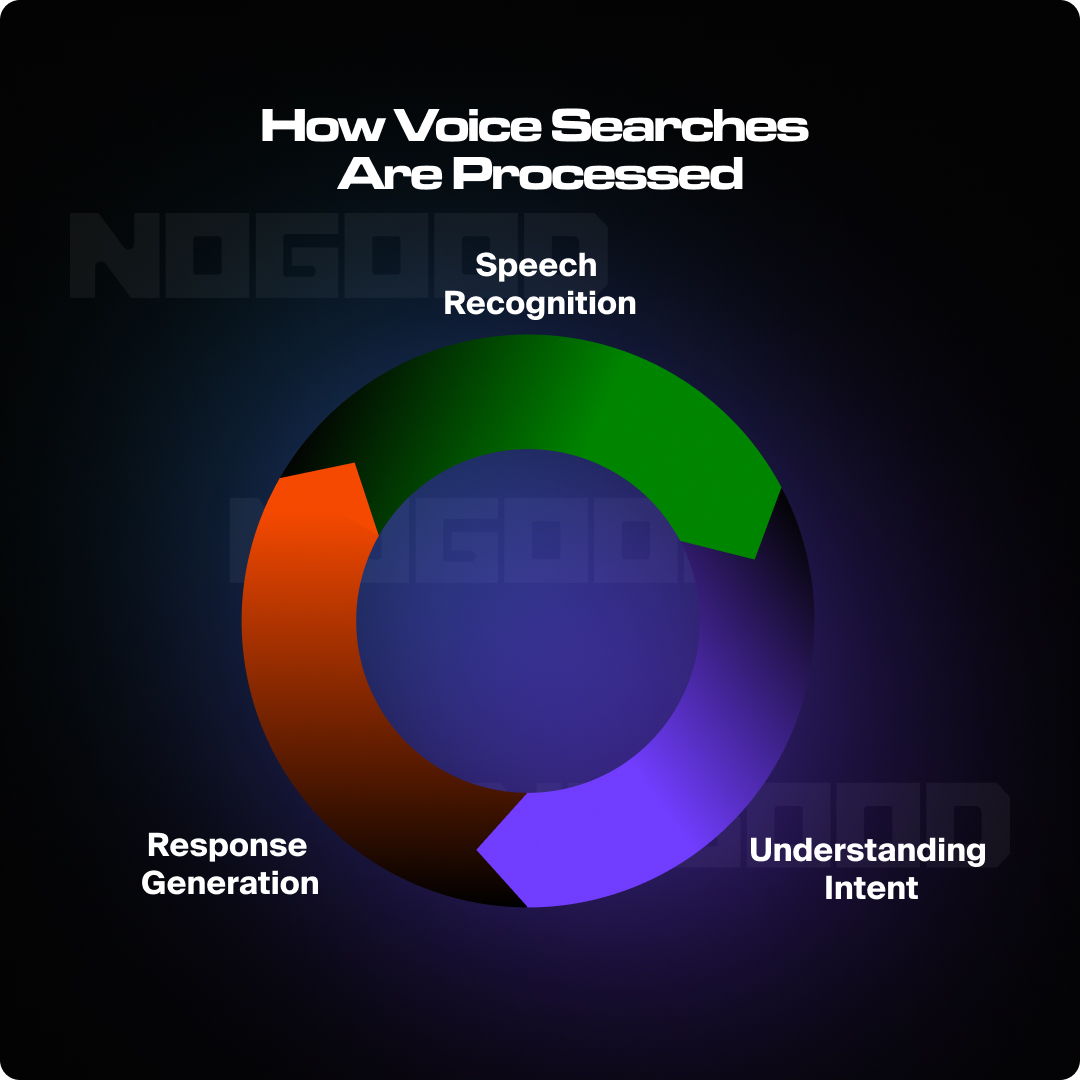With more people using voice assistants than ever before, it’s no wonder voice search e-commerce transactions surged over 400% from 2021 to 2023, reaching 19.4 billion.
Voice search requires a more conversational approach to content, focusing on long-tail keywords and natural language that aligns with how people speak. Imagine asking your voice assistant for “the best eco-friendly running shoes with free shipping”—that’s the kind of query e-commerce sites need to be ready for.
Want to drive more sales through voice search?
How Voice Searches Are Processed

Voice assistants use Natural Language Processing to understand and respond to voice queries.
Here’s how this process goes down:
- Speech Recognition: The spoken words are first converted into text using Automatic Speech Recognition (ASR).
- Understanding Intent: Next, NLP algorithms analyze the text to discern the user’s intent. This involves several components:
- Syntax and Semantics: The system examines the structure of sentences and the meanings of words to understand how they relate to each other. The algorithm can then correlate the words with topics and semantically related words.
- Contextual Analysis: NLP considers context, including previous interactions and specific phrases, to provide relevant answers. For example, a voice query like “What’s a good dinner recipe?” requires understanding that “dinner” refers to a meal context.
- Response Generation: After determining the user’s intent, the system retrieves information from various sources (like search engines) and compiles it into an organized response. This response may be read back to the user or displayed on a screen.
6 Strategies to Optimize Your E-commerce Store for Voice Search

1. Optimize for Natural Language and Long-Tail Keywords
Voice search is all about sounding natural. People speak to digital assistants like they’re having a chat with a friend, so your content needs to reflect that. This means weaving conversational language and long-tail keywords into your e-commerce site.
Consider your product descriptions, FAQs, and blog posts as opportunities to incorporate these patterns. Voice queries are typically longer and more specific than text searches. Frame questions in a way that reflects how people naturally speak. If you’re selling hair care products, you might include phrases like, “What’s the best type of conditioner for curly hair?” or “How often should I wash my hair?”
Many voice searches are phrased as questions. Include question words like “how,” “what,” “where,” “when,” and “why” in your content and headers to match these query types. When answering long-tail keyword questions, aim to keep responses around 30 words or less. This aligns with Google’s tendency to use short, concise answers for voice search results.
2. Leverage Customer Reviews
They contain natural language and real-world usage scenarios that digital assistants can tap into for answers. Encourage your customers to leave detailed reviews about their experiences. Not only do these reviews build trust with potential buyers, but they also enhance your site’s relevance in voice search results by providing genuine content that aligns with how people speak.
Voice search algorithms reference customer reviews to verify information about products and determine which products to recommend.
Voice assistants often prioritize businesses with positive reviews when responding to queries. For example, if a user asks “What’s the best computer for developers?”, the assistant will likely recommend computer models and brands with high ratings and positive reviews.
When answering queries, voice assistants may read out brief snippets from customer reviews to provide more context or support their recommendations. This helps users get a quick sense of others’ experiences.
The content of reviews helps voice assistants understand the specific strengths or offerings of a brand and its products, allowing them to match user queries more accurately. For instance, if many reviews mention an athleisure brand’s yoga line, the assistant might recommend it for a query about the best yoga pants.
As AI becomes more sophisticated, voice assistants are better at interpreting user intent. Reviews provide valuable data that helps assistants understand what users are looking for when they make specific queries.
To leverage customer reviews, businesses should:
- Encourage satisfied customers to leave reviews on your website and platforms like Google, TrustPilot, and Amazon.
- Respond to reviews, both positive and negative, to demonstrate engagement.
- Focus particularly on Google reviews, as Google is a major player in voice search
3. Optimize for the AI Overview Box
The featured snippet is prime real estate in search results, often referred to as “position zero.” Capturing this spot means your content is likely to be read aloud in a voice search response. To optimize for it, focus on creating content that directly answers common questions in a succinct, structured format. Use bullet points, lists, or short paragraphs to make it easy for search engines to pull your content into the snippet.
Start by identifying keywords you already rank well for. Focus on those that have the potential for featured snippets. Use tools like SEMrush or Ahrefs to analyze which of your keywords are already appearing in snippets and which ones have high search volumes but no current snippet.
To optimize your content for the featured snippet, target question-based keywords like “what”, “how”, “why” and use this question as your header tag. Then provide clear, concise answer directly below the header. Aim to answer the target question directly in about 40-60 words as this is the length of a typical featured snippet.
4. Improve Mobile Experience
Google employs mobile-first indexing, meaning it primarily uses a site’s mobile version for ranking and indexing. With over half of all internet traffic coming from mobile devices and a substantial portion of that involving voice searches, having a mobile-optimized site is essential for visibility in these results.
Additionally, mobile-friendly sites typically load faster, which is crucial because voice search users expect quick answers. A fast-loading site enhances user experience and improves the likelihood of appearing in featured snippets—the prime source for voice search responses.
Optimizing for mobile ensures that content is easily accessible and navigable on smaller screens, aligning with the conversational nature of voice queries. Businesses can further enhance their relevance and authority by focusing on long-tail keywords and structured data that cater to voice search patterns, ultimately increasing their chances of being featured in voice search results.
Simplify Layouts
Keep designs clean and uncluttered. A minimalist approach helps voice assistants focus on key actions without distractions. Use white space strategically to enhance readability and navigation.
Responsive Design
While focusing on mobile-first, ensure that your design can scale up effectively to larger screens. This involves progressively enhancing the design as screen size increases, allowing for additional features without compromising the mobile experience. Responsive design helps voice assistants navigate your content more efficiently, increasing your chances of being featured in a response.
Page Speed Optimization
Voice search users expect quick responses. A fast-loading site ensures that users can access information quickly after a voice query. Faster sites are also more likely to rank higher and be selected as voice search responses.
Here’s how to optimize your page speed:
- Implement Accelerated Mobile Pages (AMP). These pages load extremely quickly on mobile devices and can improve your chances of being selected for voice search results.
- Compress and resize images to reduce file sizes without sacrificing quality.
- Minify CSS, JavaScript, and HTML files to reduce their size. Combine multiple files where possible to reduce HTTP requests.
- Improve your server’s configuration and resources to reduce Time to First Byte (TTFB). Aim for a server response time under 200ms.
- Use lazy loading for images and videos so they only load as the user scrolls down the page, improving initial load times.
- Eliminate any unnecessary plugins or scripts that could be slowing down your site.
- Use asynchronous loading for CSS and JavaScript. This allows multiple files to load simultaneously, reducing overall load time.
Creating a Seamless Mobile Checkout Process
A seamless checkout process can lead to higher conversion rates for voice-initiated purchases. When the process is smooth and straightforward, users are more likely to complete their transactions than abandon them due to complications. Users can focus on their purchase decisions by simplifying the checkout process rather than navigating a complex system. This is particularly important in voice search, where visual cues are limited or non-existent.
To create a seamless shopping experience:
- Enable Apple Pay and Google Pay to allow customers to pay without manually entering card info
- Limit the number of screens involved in the checkout process
- Integrate voice-enabled payment methods like voice-activated digital wallets or voice biometrics for authentication.
- Utilize auto-fill features that can populate form fields based on previously saved information or voice commands, reducing the need for manual input.
- Provide a clear order summary that can be read aloud before final confirmation, allowing users to verify their purchase details through voice interaction.
5. Implement Structured Data
The two most important types of structured data for e-commerce sites are: product schema and FAQ schema.
FAQ schema helps voice assistants easily find and read out information about your brand, products, and store policies. This type of markup tells voice assistants that the section is an FAQ section so they know to look there for quick answers.
For example, if someone wants to order a product but they first want to check the return policy, it would be helpful for the return policy to be in FAQ format with schema markup. Voice assistants are trained to look to FAQ sections to pull direct answers from.
To take your FAQ section a step further, you can implement speakable schema which highlights sections of your content that are most suitable for text-to-speech. This helps voice assistants identify the most relevant parts of your content to read aloud.
The second type of structured data you’ll want to implement is product schema. This markup helps voice assistants find key product details like price, availability, and reviews. For example, let’s say a user is looking for hair products for curly hair with free shipping. Products with schema markup detailing, the different products, their availability, and their reviews will be more likely to be featured in voice queries.

Google recommends using JSON-LD for structured data implementation. It allows you to add schema markup in a script tag within the HTML of your page without affecting the visible content. Here’s a basic example:

After implementing the schema, use tools like Google’s Schema Markup Testing Tool to ensure that your markup is correct and free of errors.
6. Create FAQ Pages and Answer-Based Content
FAQ pages are your secret weapon in voice search optimization. By anticipating the questions your customers might ask and providing clear answers, you position your site as a go-to resource. Since voice search queries are usually phrased as questions, FAQ sections are a common source voice assistants often pull answers directly from.
Think about common inquiries regarding your products or services and craft concise, informative responses. This not only helps with voice search but also enhances user experience by providing quick answers.
Analyze customer inquiries through support tickets, customer service interactions, and social media to identify common questions about your products or services. You can also use Google Gemini to find out what people are searching for regarding your brand, products, and industry.
You’ll then create a detailed FAQ section with schema markup on your product pages. For each question use, what, where, when, how, who to align with users natural language and aim to directly answer the question in a succinct paragraph.
Voice assistants want to provide the answer to the user quickly, so short, yet informative snippets work best here. Keep it short and only include the information you need to answer the question.
It can be helpful to structure the FAQ section into categories for easier navigation. You can group questions by topics such as shipping, returns, product details, and account management to help both users and voice assistants easily access your content.
The Future of Voice Search for E-commerce
As voice assistants become more integrated into everyday life, consumers are increasingly using them for shopping. By 2025, it’s projected that half of all online searches will be voice-based, indicating a shift toward voice commerce as a mainstream shopping method.
The integration of AI in voice search is going to make the shopping experience more seamless and personalized. As natural language processing evolves, voice assistants will better grasp the nuances of human speech, allowing them to engage in more human-like interactions. This means customers could soon be having conversations with their devices that mimic those with in-store sales representatives, complete with product suggestions and personalized offers.
Improvements in NLP will enable voice assistants to understand context and intent better, making interactions more seamless. Artificial intelligence will play a significant role in personalizing voice search experiences. By analyzing user behavior and preferences, voice assistants can provide tailored product recommendations, enhancing the shopping experience.
Work with the #1 digital marketing agency for e-commerce brands






